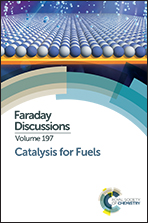Theoretical insights into the sites and mechanisms for base catalyzed esterification and aldol condensation reactions over Cu†
Abstract
Condensation and esterification are important catalytic routes in the conversion of polyols and oxygenates derived from biomass to fuels and chemical intermediates. Previous experimental studies show that alkanal, alkanol and hydrogen mixtures equilibrate over Cu/SiO2 and form surface alkoxides and alkanals that subsequently promote condensation and esterification reactions. First-principle density functional theory (DFT) calculations were carried out herein to elucidate the elementary paths and the corresponding energetics for the interconversion of propanal + H2 to propanol and the subsequent C–C and C–O bond formation paths involved in aldol condensation and esterification of these mixtures over model Cu surfaces. Propanal and hydrogen readily equilibrate with propanol via C–H and O–H addition steps to form surface propoxide intermediates and equilibrated propanal/propanol mixtures. Surface propoxides readily form via low energy paths involving a hydrogen addition to the electrophilic carbon center of the carbonyl of propanal or via a proton transfer from an adsorbed propanol to a vicinal propanal. The resulting propoxide withdraws electron density from the surface and behaves as a base catalyzing the activation of propanal and subsequent esterification and condensation reactions. These basic propoxides can readily abstract the acidic Cα–H of propanal to produce the CH3CH(−)CH2O* enolate, thus initiating aldol condensation. The enolate can subsequently react with a second adsorbed propanal to form a C–C bond and a β-alkoxide alkanal intermediate. The β-alkoxide alkanal can subsequently undergo facile hydride transfer to form the 2-formyl-3-pentanone intermediate that decarbonylates to give the 3-pentanone product. Cu is unique in that it rapidly catalyzes the decarbonylation of the C2n intermediates to form C2n−1 3-pentanone as the major product with very small yields of C2n products. This is likely due to the absence of Brønsted acid sites, present on metal oxide catalysts, that rapidly catalyze dehydration of the hemiacetal or hemiacetalate over decarbonylation. The basic surface propoxide that forms on Cu can also attack the carbonyl of a surface propanal to form propyl propionate. Theoretical results indicate that the rates for both aldol condensation and esterification are controlled by reactions between surface propoxide and propanal intermediates. In the condensation reaction, the alkoxide abstracts the weakly acidic hydrogen of the Cα–H of the adsorbed alkanal to form the surface enolate whereas in the esterification reaction the alkoxide nucleophilically attacks the carbonyl group of a vicinal bound alkanal. As both condensation and esterification involve reactions between the same two species in the rate-limiting step, they result in the same rate expression which is consistent with experimental results. The theoretical results indicate that the barriers between condensation and esterification are within 3 kJ mol−1 of one another with esterification being slightly more favored. Experimental results also report small differences in the activation barriers but suggest that condensation is slightly preferred.
- This article is part of the themed collection: Catalysis for Fuels


 Please wait while we load your content...
Please wait while we load your content...